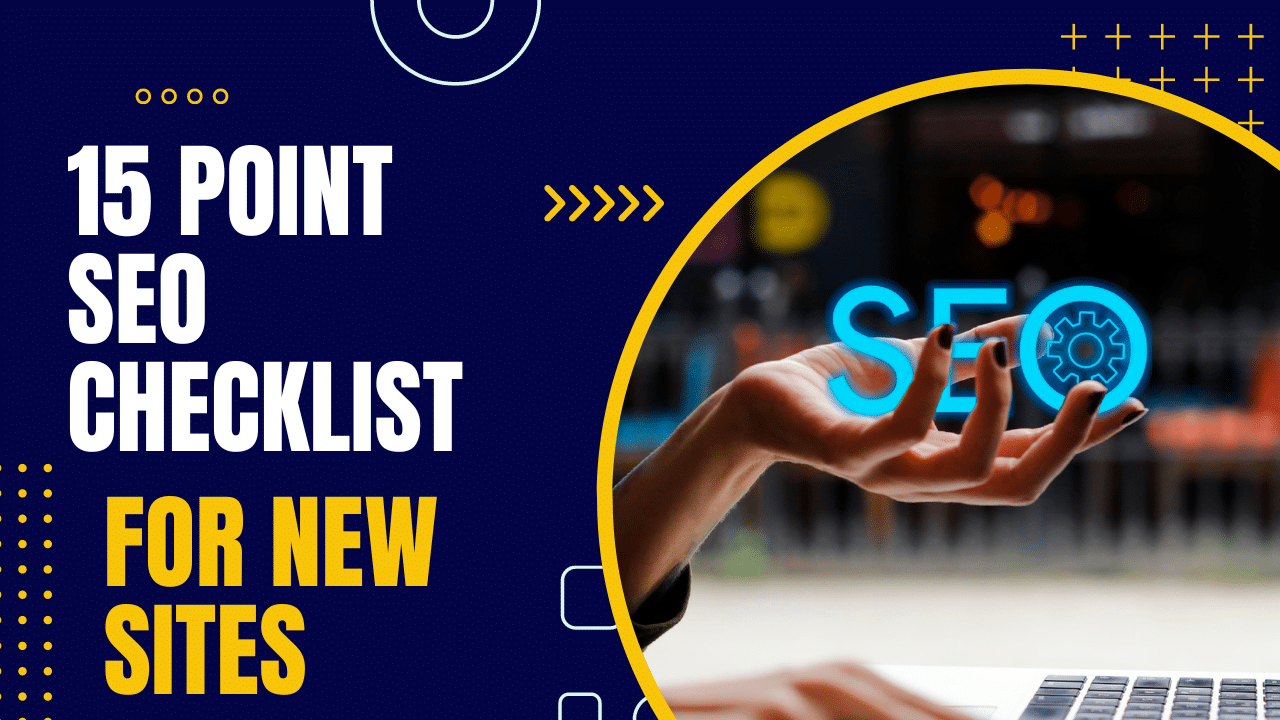For many webmasters and online business owners, especially beginners, the world of SEO can be daunting to understand. What may seem like an easy to understand concept in SEO might require years of experience and research to understand and master. Similarly, it can take a while for a new website to establish its authority, ranking and gain a significant amount of traffic through SEO. New SEO trends, frequent changes in Google’s algorithm, technology, increasing competition in the online marketing space and AI can make it more difficult for a new website to get ranked on top of a search engine result page. So, if you are looking for a new website SEO checklist to level up your SEO game in 2025, then keep reading this blog post till the end. In this post, you’ll come across not 1 but a 15-point SEO checklist for new site owners. By leveraging these 15 points fully, you can surely take your SEO game to the next level.
Importance of SEO for new websites
Before moving ahead, let us first understand the importance of SEO for new websites. Search engine optimization [SEO] is the process of optimizing a website for users and major search engines like Google, Yahoo, Bing and Baidu. By improving your website’s ranking on search engine result pages, you can drive more organic traffic to your site, which helps generate more leads and conversions. This, in turn, can enhance your business through effective sales management solutions. SEO not only helps to drive traffic to your website but it is also a valuable tool for building your brand and reputation in the online world.
15 Point SEO checklist for new websites
1. Plan a website architecture
Website architecture is first in our SEO checklist, before making your original website live. Most of the websites follow a pyramid-style website architecture which has a homepage on the top followed by sub-pages and sub-categories for services and products that you are offering. You can also create Silos which Google to better crawl and index your website. A good website architecture is not only important for SEO but also for users as it makes navigation smooth and easy. You can further enhance the site architecture by using breadcrumbs or navigational links at the top of every page. This will not only help users to discover web pages more easily but also improve the overall credibility of your website.
2. Submit your website to Google
If the basic design of your website is done it is now time to put your website up in the online world. This is the most important step if you want to get your website ranked on top of Google search results organically. Until and unless you won’t submit your website to Google, the search engine bot won’t be able to crawl and index your website. In order to get your website indexed, you need to create and submit the website’s sitemap in the Google search console tool and also verify the ownership of your domain. Once you are done with this, your site will start appearing on Google search for relevant search terms and keywords. You can also use Google Ads to appear in search results and implement a Google Ads report to understand your ads’ performance and what you need to improve, making Google Ads for small business an excellent way to gain immediate visibility. To create a sitemap, you can use an online sitemap generator tool or Yoast SEO plugin if you have a WordPress-built website. If you are using an online store builder, a sitemap is created automatically.
3. Keyword planning is the foundation of SEO
Here comes yet another important SEO checklist for a new website, which is keyword planning and research. Keywords are the foundation of the entire SEO plan. They can either take your SEO game to the next level or take it downhill. So, make sure to target the right keywords which are relevant to your business and SEO. You can start the keyword research by finding out some primary and secondary keywords which best describe your business or take help from a b2b SEO agency, which can analyze your industry, research high-intent keywords, and identify the terms that will attract qualified B2B leads.
For example; If you own a cake shop in Chicago, then the following can be the best set of keywords for your business
- Best cake shop in Chicago
- Top cake shop in Chicago
- Cake shop and bakery in Chicago, Downtown
Once you have created a bucket of keywords, you can optimize the keywords in the title, meta, URL and content of your website. This will help Google bot to understand the context of your content and will give a significant boost to your website’s ranking. While doing keyword research it is important to keep the following points in mind.
- Your targeted keywords must have a significant search volume
- Your targeted keywords must have less competition
- Your keyword should be relevant to your service or product offering
To find out the best keywords for your business, you can use tools like Ahrefs, SEMrush, Ubersuggest or Google Keywords Planner.
Do You Need Web Design
and Development Services?
Strategy
Design
Development
Support
4. Start curating content for your new website
Until and unless you don’t have a significant amount of content on your website it will be a daunting task to get the number 1 spot on SERP. Content is king in the online marketing world and Google takes this very seriously. Having well-optimized content for each web page, service page and product page will surely give you an edge over your competitors in organic SEO rankings. In fact, SEO is all about curating content for users that matches their interests and satisfies their queries. Since the helpful content update, Google is giving more preference to websites that produce content to satisfy the users rather than satisfying search engine bots. That said, it is important to note that users don’t really like long content. They prefer reading short content pieces that they can go through easily. A summarizer can come in handy here as it will adjust the text to the appropriate length itself. In addition to concise text, many websites also use visual content like explainer videos created with an AI video generator to improve engagement, dwell time, and overall content performance. To create content , you can also get help from AI paragraph rewriter by SEO Magnifier.
AI writing and rewriting tools can surely help you with content creation, but the content you’ll get might sound overly formal or robotic. Therefore, it is important to humanize AI text before putting it before your audience. For this task, you can also take help from Rephraser.co’s AI Text Humanizer.
To create helpful content, you can follow these steps:
- Do keyword research for each topic with the help of SEO agency.
- Organize the keywords into content ideas based on the buying process of your target audience.
- Write 1500+ words of content. More words = better rankings.
- Optimize it for users first and then for search engines.
- Add relevant internal links
- Promote your content.
- Build some external backlinks.
If the content is king then backlinks are kingmakers. Backlinks are the most crucial ranking factor in Google. Your content may be top-notch, but if you don’t have high authority backlinks to it, your content won’t rank on Google. A backlink is nothing but an outbound hyperlink that points from one website to another. Google considers backlinks as a vote of recommendation. The more backlinks your web page has, the better your rankings will be. Link building also affects your SEO in many ways. That’s why you need an extensive list of prospects to outreach, and a Link Building can help you acquire high-quality backlinks efficiently. Additionally, you can explore various ways to find the email addresses of your prospects by using an email finder tool or an SEO reseller service and contact them.
There are two different types of backlinks in SEO.
- Do-follow links: Do-follow link passes link juice from one page to another.
- No-follow links: No-follow links do not pass link juice from one page to another and there is no SEO valve attached to no-follow links.
If you want to get your website ranked on Google, focus more on getting high-quality do-follow links. You can also follow a ratio of 80-20 while creating links. 80% of your links should be do-follow and 20% should be no-follow. Besides, you should also create backlinks by keeping the anchor text in mind. Anchor text is nothing but a highlighted HTML text which you get a link from.
Following are some tips to make high backlinks:
- Contribute guest articles on the website.
- Start blogger outreach.
- Get a link from unlinked brand mentions.
- Contribute to round-up posts.
6. Improve your website’s speed
Whether you agree with us or not, website speed is a ranking factor and Google has made it official in the year 2018. Besides, having a slow website will not only impact your website’s ranking negatively but it leads to a decline in traffic, conversions and sales, which will ultimately hamper the overall profitability of your business. Moreover, Google has developed a new set of metrics called Core Web Vitals, which it uses to measure page experience. And website loading performance along with interactivity and visual stability of the page are important parts of Core Web Vitals. You can check the speed of your website on the Google page speed testing tool. Generally, your website should load within 2-3 seconds on desktop as well as mobile devices.
In case, your site is taking too long to load, here are a few tips you can apply on your website.
- Upgrade to a good and reliable hosting
- Check for DNS propagation issues.
- Leverage content delivery networks [CDN]
- Compress large media files like images and videos
- Avoid using too much flash content on your site
7. Make it mobile-friendly
In the year 2018, Google rolled out a mobile-first indexing approach which means, a Google bot will look at the web pages from a mobile device to determine the responsiveness of a website. This clearly means having a responsive website is of utmost importance for new website owners who are looking for ways to rank their website better on Google SERP. You can always access the mobile-friendliness of your website by using the Google search console tool or mobile-friendly testing tool by Google.
Following are some tips to make your website more mobile-friendly:
- Make your design responsive
- Optimize all the images
- Avoid too much fash content and graphics
- Keep testing the responsiveness of your site
8. Keep auditing your website
An SEO audit is similar to getting your regular health checkup. As you know, regular health checkups can be the most significant way to live a healthy life and detect possible diseases at every stage. In a similar way, conducting regular SEO audits will help you to detect issues hampering your site’s visibility and ranking in the search engine. If your website is properly optimized, the overall health score of your website will go down and you’ll lose search engine traffic as well as conversions.
Therefore, it is of utmost importance to do regular audits of your website. The following are the things you should check while auditing your website:
- Audit the speed of your website and mobile friendliness.
- Check your sitemap and keep it updated.
- Check and remove spammy backlinks.
- Check for 404 error pages and redirects.
- Do a content audit, check keywords and keep updating your content.
- Do a technical SEO audit for your website using tool like SeoProfy.com.
9. Audit your Google My Business profile
If you want to rank your website on Google Maps, then optimizing and auditing your Google business profile is a must. In our SEO checklist Google business profile is very important to consider. It is an effective tool that will allow you to manage the online presence of your business across the globe. You should audit your business name, phone number, location, description, services or products that you offer, working hours and event updates. Make sure to give all the relevant information that goes in tandem with your business.
Read More: How Long Does It Take To Design and Develop a Website?
10. Create SEO-friendly title & meta
Title and meta description are yet another important part of your SEO strategy. It helps Google and users to give the actual context of a web page. So, you must create SEO friendly titles and meta descriptions. The rule of thumb should be to include your primary keyword in the title tag and meta description. You must also keep the character limit in mind. The title tag should be between 55 to 60 characters while the meta description can go up to 160 characters. You can use free tools for Meta Tag Analyzer to check your tags are optimized. Additionally, you can use an AI title generator to quickly craft compelling and keyword-rich titles that improve click-through rates
11. Secure your website with SSL
Do you know? HTTPS is a ranking signal for Google. Users’ security is the top priority for Google, so it makes sense to secure your website with an SSL certificate. You can ask your hosting or domain name provider for a free SSL certificate. Having an SSL certificate will not only help you to improve your website’s SEO but also gain the trust of your customers, especially if you are in the e-commerce business.
12. Internal links are a must
Internal links are yet another important SEO checklist for new website owners. Many webmasters already know the importance of internal links for SEO still many of them overall this factor and regret later. Internal links help to pass the link juice from one web page to another which increases the ranking of low-authority web pages in Google SERP. When adding any internal links you must check for the relevancy of the web pages and keywords. Generally, a web page must have 4-5 relevant internal links.
13. Optimize the images
SEO is not just about optimizing textual content, images are also an important part of SEO and help to get a significant amount of organic traffic via Google image search. So, make sure that your images on the site are fully SEO optimized.
Following are some tips for image optimization:
- Compress all the images
- Have relevant file names for images
- Add image alt text
- Have a featured image for your blogs
14. Use schema
Schema markup helps search engine bots to better understand the context of your web page or content. Apart from that, it also helps webmasters to show rich results in Google search for specific web pages or content types. Also, users like to visit a web page more frequently than has been optimized by the schema. Therefore, you must include Schema on all your relevant web pages.
15. Keep an eye on your competitor’s SEO
Last on this list of 15 point SEO checklists for new sites is keeping an eye on your competitor’s SEO strategy. This will give you critical insights about your competitor’s SEO plan and what techniques are they leveraging to rank their websites on Google. Using a Google scraper can streamline this process by automatically collecting competitor data, helping you analyze their keywords, backlinks, and content strategies more efficiently. You can keep an eye on their keywords, backlink profile, content strategy, social media profile and Google my business page to get some information. You can white label SEO tools like Ahrefs or SEMrush to do a detailed analysis of competitors’ sites.
Conclusion:
Simpalm is the best web design agency in Virginia, we offer SEO friendly and responsive website to our clients. We have completed 100+ web projects since 2009, we that experience we have created this SEO checklist for new sites is surely a guide to establishing a strong online presence for your business. By following these 15 tips, you can surely open the floodgate of organic traffic and position their website for success in the digital landscape.

 App Development
App Development Web Engineering
Web Engineering AI Services
AI Services Startups
Startups Health / Fitness
Health / Fitness Education
Education Social
Social Nonprofit
Nonprofit Fintech
Fintech Logistics
Logistics Government
Government HR Software
HR Software About Simpalm
About Simpalm Our News
Our News Client Testimonials
Client Testimonials Careers
Careers Awards
Awards Resources
Resources Information
Information


